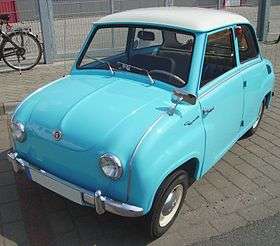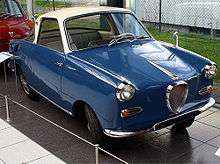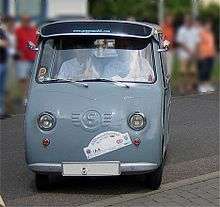Goggomobil
| Goggomobil | |
|---|---|
 | |
| Overview | |
| Manufacturer |
Hans Glas GmbH (1955–1966) BMW (1966–1969)[1] |
| Production | 1955–30 June 1969[2] |
| Body and chassis | |
| Class | Microcar |
| Layout | RR layout |
| Body style(s) |
2-door sedan[2] 2-door coupe[3] 2-door convertible [4] Van[5] Pickup [6] Roadster (Goggomobil Dart)[7] |
| Vehicles |
Goggomobil T (2-door sedan)[2] Goggomobil TS (2-door coupe)[3] Goggomobil TL (van)[5] Goggomobil Dart (roadster)[7] |
| Powertrain | |
| Engine(s) |
Two-stroke straight-two engine 245 cc, 13.6 hp (10.1 kW) (DIN) 293 cc, 14.8 hp (11.0 kW) (DIN) 392 cc, 18.5 hp (13.8 kW) (DIN)[2][3][5] |
| Transmission(s) |
4-speed manual electromagnetic pre-selector transmission optional[2][3][5] |
| Dimensions | |
| Wheelbase | 1,800 mm (71 in)[2][3][5] |
| Length |
2-door sedan: 2,900 mm (110 in)[2] 2-door coupe: 3,035 mm (119.5 in)[3] Van: 2,910 mm (115 in)[5] |
| Width |
2-door sedan: 1,260 mm (50 in)[2] 2-door coupe: 1,370 mm (54 in)[3] Van: 1,316 mm (51.8 in)[5] |
| Height |
2-door sedan: 1,310 mm (52 in)[2] 2-door coupe: 1,235 mm (48.6 in)[3] Van: 1,695 mm (66.7 in)[5] |
Goggomobil was a series of microcars produced in the Bavarian town Dingolfing after World War II by Glas.
Glas produced three models on the Goggomobil platform: the Goggomobil T sedan, the Goggomobil TS coupé, and the Goggomobil TL van. The engine was an air-cooled, two-stroke, two-cylinder unit originally displacing 250 cc, but later available in increased sizes of 300 cc and 400 cc. It had an electric pre-selective transmission built by Getrag and a manual clutch. The engine was behind the rear wheels. Suspension was independent all round using coil springs with swing axles.
214,313 sedans, 66,511 coupés, and 3,667 Transporter vans and pickups were built from 1955 to 1969.
T sedan
The Goggomobil T250 was introduced by Glas at the 1954 IFMA international bicycle and motorcycle show. The T250 was a conventional-looking two door sedan with a rear-mounted 245 cc air-cooled two-stroke straight twin engine.
Design changes were made to the T250 in 1957. Two windshield wipers were used instead of the earlier system with one wiper, and the sliding windows in the doors were changed to wind-up windows. Also at this time the T300 and T400 became available; these had larger engines of 300 cc and 400 cc respectively.
The last design change for the T sedan came in 1964, when the rear-hinged suicide doors were replaced by conventional front-hinged doors.
214,313 sedans were built when production ended on 30 June 1969.[2]
TS coupe

The Goggomobil TS 2+2 coupe was introduced at the 1957 IFMA show alongside the improved T sedan. It was available as the TS250, the TS300, and the TS400, the number reflecting the approximate engine size in cubic centimeters.
The only major design change to the TS coupe was the change from rear-hinged suicide doors to front-hinged conventional doors in 1964.
The TS coupe was always ten to twenty percent more expensive than the T sedan. Total production of TS coupes was 66,511.[3]
TS 300 specifications and performance
The specifications of a 1957 Goggomobil TS 300 Coupe are:
- Configuration — Glas 2-stroke rear engine, 298 cc displacement
- Engine — 2-cylinder, 2 stroke, air-cooled, 58 x 56 mm. bore and stroke, 6.0:1 compression, 15 hp. at 5,000 rpm, 17.4 lb·ft (24 N·m) torque.
- Transmission — 4 speed plus reverse (with electric pre-selector as an available option).
- Top Speed — 85 km/h (53 mph)
- Tires — 4.80 x 10 inch.
- Weight — 420 kg (926 lb).
- Wheelbase — 71 in (1,800 mm) [8]
- Height - 49 in (1,200 mm) [8]
- Length - 114.5 in (2,910 mm) [8]
- Width - 53 in (1,300 mm) [8]
A TS300 coupé tested by the British magazine The Motor in 1957 had a top speed of 59.2 mph (95.3 km/h) and could accelerate from 0 to 50 mph (80 km/h) in 27.9 seconds. A fuel consumption of 50.5 miles per imperial gallon (5.59 l/100 km; 42.1 mpg-US) was recorded. The test car cost £625 including taxes of £209 on the UK market.[8]
_Heck.jpg)
TS 250 specifications
The specifications of a 1958 Goggomobil TS 250 Coupe are:
- Configuration — Glas 2-stroke rear engine, 247 cc displacement
- Engine — 2-cylinder, 2 stroke, air-cooled, 13.6 hp. at 5,000 rpm
- Transmission — 4 speed plus reverse
- Top Speed — 75 km/h (47 mph)
- Tires — 4.40 x 10 inch
- Weight — 415 kg (915 lb)
Goggomobil Transporter TL van

The Goggomobil Transporter, or Goggomobil TL, was introduced at the 1956 IFMA show. The Transporter was built largely at the request of the German Federal Postal Service, which procured more than 2,000 Transporters between October 1957 and November 1965.[5]
The Transporter had sliding front doors. It was available as an enclosed van with double back doors or as a pickup with a tailgate to the open bed. Transporter pickups were often used by municipal services as snow plows or street sweepers.[5][9]
3,667 Transporter vans and pickups were produced.[5]
US export editions
Goggomobils were exported to the United States. These were special export versions, with the 400 cc engine, an automatic gasoline-oil mixer, and 7 inch sealed beam headlights as required by US regulations.[2][3][10]
Goggomobil Dart
Between 1957 and 1961 some 700 sports cars called Goggomobil Darts were produced by Buckle Motors Pty Ltd in Sydney, Australia.[7] Other Goggomobil models were also produced under licence,[11] including saloon, coupe, coupe-convertible and light van variants.[12] These were fitted with Australian produced fibreglass bodies based on a Sunbeam Alpine in place of the steel bodies of their German counterparts.[11] Australian production totalled approximately 5,000 units.[11]
References
- ↑ Norbye, Jan P. (1984). "Expanding on Excellence: The 5-Series and 3-Series". BMW - Bavaria's Driving Machines. Skokie, IL, USA: Publications International. p. 192. ISBN 0-517-42464-9.
- 1 2 3 4 5 6 7 8 9 10 11 "GLAS Automobil Club International e.V. - Vehicles - Goggomobil Sedan". Web.archive.org. 2011-07-26. Archived from the original on July 26, 2011. Retrieved 2012-10-12.
- 1 2 3 4 5 6 7 8 9 10 "GLAS Automobil Club International e.V. - Vehicles - Goggomobil Coupé". Web.archive.org. 2011-07-26. Archived from the original on July 26, 2011. Retrieved 2012-10-12.
- ↑ UK Sales brochure for Goggomobil Regent & Mayfair models Retrieved from www.webcitation.org on 19 January 2012
- 1 2 3 4 5 6 7 8 9 10 11 "GLAS Automobil Club International e.V. - Vehicles - Goggomobil Van". Web.archive.org. 2011-07-26. Archived from the original on July 26, 2011. Retrieved 2012-10-12.
- ↑ The Goggomobil Van, GLAS Automobil Club International e.V. Retrieved on 18 January 2012
- 1 2 3 "The Bruce Weiner Motorcar Museum - 1958 Goggomobil Dart". Microcarmuseum.com. Retrieved 2012-05-06.
- 1 2 3 4 5 "The Goggomobil TS 300 Coupé". The Motor. September 18, 1957.
- ↑ "Bruce Weiner Microcar Museum - 1959 Goggomobil Transporter Pickup". Microcarmuseum.com. Retrieved 2012-05-06.
- ↑ "MicroCar Club: 1958 Goggomobil TL-250 Transporter". Microcar.org. Retrieved 2012-05-06.
- 1 2 3 Pedr Davis, The Macquarie Dictionary of Motoring, 1986, page 194
- ↑ David Berthon, Tiny Goggomobil turns 50, The Sydney Morning Herald, August 22, 2008 Retrieved from www.drive.com.au on 19 January 2012.
- Taschen, Benedikt. Kleinwagen, Small Cars, Petites Voitures, 1994.
External links
| Wikimedia Commons has media related to Glas Goggomobil. |
- http://www.goggomobil.com/ehome/ehome.html
- http://www.californiaclassix.com/archive/59_Goggo.html
- http://www.microcarmuseum.com/tour/goggo-t250sunroof.html
| Glas car timeline 1955 to 1969 | |||||||||||||||||||||
|---|---|---|---|---|---|---|---|---|---|---|---|---|---|---|---|---|---|---|---|---|---|
| Typ | Independent (Hans Glas GmbH) | BMW | |||||||||||||||||||
| 1950s | 1960s | 1970s | |||||||||||||||||||
| 5 | 6 | 7 | 8 | 9 | 0 | 1 | 2 | 3 | 4 | 5 | 6 | 7 | 8 | 9 | 0 | 1 | 2 | 3 | 4 | ||
| City car | Goggomobil T | ||||||||||||||||||||
| Supermini | Isar | ||||||||||||||||||||
| Compact car | 1004, 1204, 1304 | ||||||||||||||||||||
| Family car | 1700 | 1800 SA, 2000 SA / 1804, 2004[1] | |||||||||||||||||||
| Coupé | Goggomobil TS | ||||||||||||||||||||
| 1300 GT, 1700 GT | 1600 GT[2] | ||||||||||||||||||||
| 2600 V8, 3000 V8 | 3000 V8[3] | ||||||||||||||||||||
| Van | Goggomobil TL | ||||||||||||||||||||
| *BMW-era [1]: the "BMW" (only for South Africa by Praetor Monteerders) until mid-1974, [2] as "BMW", [3] as a "BMW-glass" | |||||||||||||||||||||